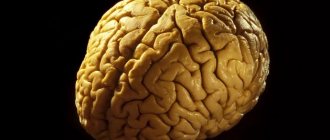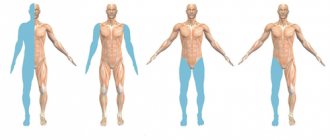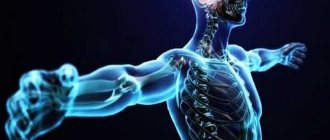Possible complications
The probability of developing complications after an artificially induced coma is quite high, and is determined by its duration. Most often, patients develop:
- heart failure;
- heart failure;
- bedsores;
- blood flow disorders;
- sudden changes in blood pressure;
- renal failure;
- neurological disorders;
- infectious processes in the body.
A significant danger is posed by the gag reflex, as a result of which the contents of the stomach can enter the respiratory tract and cause breathing problems. Sometimes there are difficulties with emptying the bladder, which can provoke its rupture, or the development of peritonitis.
If the patient has a weakened respiratory system, complications such as inflammation, pulmonary edema, and tracheobronchitis are possible after recovery from a coma. It is possible that stenosis, pathological changes in the functioning of the gastrointestinal tract, fistulas in the lining of the esophagus,
Severe complications after emerging from a medically induced coma can first lead to clinical and then biological death of the patient.
Causes
The sources causing damage to cerebral structures can be different.
The main ones are closed or open craniocerebral injuries caused by trauma.
Today, depression of the central nervous system caused by cancer, strokes and hemorrhage of various pathogenesis has become increasingly widespread.
The third most common causes are bacterial and viral infections that provoke inflammation and disruption of brain activity.
Distortion of consciousness can be caused by diabetes, hormonal disorders, abnormal changes in the functioning of the kidneys and liver.
Also, factors contributing to the development of a coma include intoxication and poisoning with potent poisons and substances: alcohol, drugs, medications.
Read also: Absinthe, whose national drink
Diagnosis of coma
During the period of stay in a state of artificial coma, it is necessary to diagnose the patient’s condition. The effectiveness of administered medications and the degree of vital activity of the body are controlled using:
- An electroencephalogram, which allows you to monitor the state of the cerebral cortex after head injuries, stroke, etc. For this purpose, a special device (electroencephalograph) designed for round-the-clock operation is connected to the patient’s body.
- Radioisotope control - the introduction into tissue of a special device that monitors blood circulation in parts of the brain.
- Ventricular catheter is a method of changing intracranial pressure, fixing the level of oxygen saturation of tissues and organs, and the flow of metabolism in them.
- CT and MRI, which monitor the state of blood flow, allowing one to make a prognosis regarding the further course of the coma.
Constant monitoring of the patient’s vital functions allows one to avoid cardiac arrhythmias and cardiac arrest, and to ensure timely exit from artificially created sleep.
Medical staff monitors the effectiveness of the drugs used and the depth of the coma created 24 hours a day. To avoid the appearance of bedsores on the patient’s body, he is periodically (several times during the day) turned over in bed.
The mechanism of coma during TBI
The development of coma affects the general condition of the patient, but the central nervous system is primarily affected. A disorder of its functions leads to changes in consciousness, dulling of reflexes, lack of response to external factors and the ability to contact others. The pathological phenomenon in its quality resembles very deep sleep, which is caused by inhibition of the work of certain parts of the brain.
Coma due to TBI is not an independent disease, but a consequence of a malfunction of the nervous system.
It is important to understand the mechanism of its development in order to properly treat and eliminate risks to the victim’s life.
Coma occurs as a result of extensive damage to the brain matter, as well as vital centers of the central nervous system. This causes damage to the transmission pathways of nerve impulses to all organs and systems, disruption of processes that are the key to the normal functioning of the body. Such consequences result from changes in tissue structure and circulatory disorders in certain areas. The loss of communication between the higher parts of the nervous system and functional centers is aggravated by local or general cerebral edema.
Artificial coma - why is it put into it?
Let’s find out why people are put into an artificial coma and what goals doctors pursue in doing so. This human condition is required if it is not possible to avoid irreversible changes that can lead to death. An induced coma is often considered the only option to save the patient's life.
A decrease in cerebral blood supply leads to a decrease in the activity of metabolic processes. As a result, doctors are able to reduce the likelihood of the formation of necrotic lesions in the brain. For example, the artificial coma used for severe pneumonia helps reduce the rate of degenerative changes in tissues.
Forecast
The prognosis, unfortunately, may vary. The most disappointing results most often result from a rupture of an aneurysm or a stroke, that is, a hemorrhage in the brain. The longer the victim remains in an induced coma, the less chance there is of saving him. When studying the condition, it was found that patients who remained in a coma for more than a year died in 60% of cases or remained at the level of reflexes, in 30% they received disability, 10% of people were restored to normal levels. But in some cases, a medically induced coma is the only saving chance for a person.
How is one put into an artificial coma?
Introduction to an artificial coma is carried out only in a hospital setting (resuscitation or intensive care unit). For this purpose, the patient is given special medications. As a result, the body plunges into deep sleep: complete blocking of sensitivity occurs, loss of consciousness, and shutdown of some centers.
Medicines are administered intravenously, so coma sets in quickly. After the injection, the patient is connected to a ventilator. Electrodes are placed on the surface of the chest to monitor cardiovascular activity. If necessary, the patient is connected to an electroencephalograph.
Traumatic brain injury: coma after head injury – Izvilina
Head injuries themselves pose a health hazard to the victim and can lead to serious complications. In case of serious damage to the structure of the brain substance, the patient may fall into a coma.
With it, the patient loses consciousness, does not respond to stimuli and is literally between life and death. Coma after a traumatic brain injury can manifest itself differently depending on the degree of damage to the cerebral tissue.
The lack of timely professional assistance threatens the death of the victim or the development of severe disability.
After a TBI, the victim may go into a coma.
The mechanism of coma during TBI
The development of coma affects the general condition of the patient, but the central nervous system is primarily affected.
A disorder of its functions leads to changes in consciousness, dulling of reflexes, lack of response to external factors and the ability to contact others.
The pathological phenomenon in its quality resembles very deep sleep, which is caused by inhibition of the work of certain parts of the brain.
It is important to understand the mechanism of its development in order to properly treat and eliminate risks to the victim’s life.
Coma occurs as a result of extensive damage to the brain matter, as well as vital centers of the central nervous system.
This causes damage to the transmission pathways of nerve impulses to all organs and systems, disruption of processes that are the key to the normal functioning of the body.
Such consequences result from changes in tissue structure and circulatory disorders in certain areas. The loss of communication between the higher parts of the nervous system and functional centers is aggravated by local or general cerebral edema.
In coma, the transmission of nerve impulses to organs is disrupted.
Types and symptoms of coma
Regardless of the cause of coma and its form, the main symptom of the pathological condition is impaired consciousness. Dysfunction of individual areas of the brain can manifest itself in different ways.
Often, the clinical picture of the disorder helps doctors make a preliminary diagnosis and select the best first aid options.
Symptoms that may accompany coma with different types of traumatic brain injury:
- speech disorders;
- inability to perform purposeful actions with the upper and/or lower extremities;
- sudden cramps, involuntary muscle contractions;
- rapid rhythmic movements in the knee and/or ankle joints;
- varying degrees of decrease in consciousness up to its complete shutdown and absence of reflexes;
- paralysis;
- breathing problems;
- fixation of pupils;
- heart rhythm disturbance.
In coma, the heart rhythm is disrupted.
The degree of brain damage is determined using a special Glasgow scale. To use it, you need to evaluate a number of indicators, calculate the points obtained and check which diagnosis their number corresponds to.
Superficial coma
A condition that develops in a situation where a traumatic brain injury leads to a superficial impairment of consciousness. The victim seems to be falling into a very deep sleep.
He can react to attempts by others to talk to him by opening his eyes, and sometimes with fragmentary phrases. Light, targeted movements of the limbs are possible.
Speech and conscious actions are greatly inhibited.
Actually coma
As a result of damage to large areas of the brain, the patient becomes very weak and does not respond to stimuli. Sometimes, on the contrary, he experiences a sharp increase in motor activity.
Such actions are involuntary, so doctors can fix the victim in a supine position so that he does not injure himself or others.
Due to the fact that large areas of the brain have been damaged, the person does not respond to stimuli.
Deep coma and vegetative state
A condition called deep coma usually occurs when vital parts of the brain are affected. The patient has no reflexes and no reaction of the pupils to light, he is motionless, and does not respond to pain. There is an obvious lack of vital signs, the victim is not even able to breathe on his own. He is connected to a ventilator and supportive therapy is started.
A vegetative state is distinguished separately. This is another form of consciousness disorder that occurs when the functioning of the cerebral hemispheres is disrupted while the functions of the hypothalamus are preserved. This is one of the options for exiting a deep coma when the patient has no signs of awareness of what is happening. The patient can remain awake, open and close his eyes, and has unconditioned reflexes.
Doctors characterize vegetative state as a phenomenon in which the biological functions of the body are carried out, but social and intellectual abilities are not supported.
Determination of the level of coma
Restoration of impaired or lost functions of the central nervous system is possible only after establishing the cause of the coma and its type. The first assessment of the victim’s condition is carried out before emergency care is provided.
Restoration of the central nervous system is possible only after establishing the type of coma.
Diagnosis of a patient with TBI in a coma includes:
- collecting anamnesis - interviewing the victim’s relatives, witnesses of the accident, collecting data from the patient’s medical record;
- physical examination - examination of the skin and mucous membranes, assessment of the functioning of the respiratory and circulatory system, checking the fundus of the eye and the reaction of the pupil to light. Additionally, the likelihood of spinal injuries is determined, and certain types of palpation and percussion of the body are used. They are necessary to exclude pathological enlargement of organs and the presence of internal bleeding;
- neurological tests - include checking the level of unconsciousness, eye reaction, establishing the degree of motor activity and tendon reflexivity. Muscle tone is assessed, asymmetry of the facial areas is excluded;
- laboratory and hardware tests - X-ray of the skull, MRI, CT, EEG, angiography, lumbar puncture, measurement of intracranial pressure.
If necessary, the attending physician may prescribe additional diagnostic tests. The manipulations are repeated regularly to monitor the dynamics of the patient’s condition.
To diagnose the patient, a lumbar puncture is performed.
Treatment during coma
The main tasks in the treatment of a coma are to maintain the patient’s life support, eliminate the causes that caused the coma, and prevent the death of brain tissue.
Already in the ambulance, a team of medical workers takes measures to ensure the patient’s breathing and stabilize blood circulation.
If necessary, indirect cardiac massage is performed. After being admitted to the hospital, the victim is placed in intensive care. Here manipulations are carried out aimed at restoring functions lost by the body.
Treatment of a patient with TBI in a coma may include the following:
- the use of drugs that stimulate blood flow to the brain or accelerate the elimination of swelling of the organ;
- the use of medications that stabilize blood pressure and support kidney and liver function;
- parenteral and/or tube administration of nutrients and fluids;
- carrying out antibacterial therapy to prevent the development of secondary infection;
- care of the skin and mucous membranes in order to prevent bedsores and other complications as a result of the forced immobility of the patient;
- physical therapy aimed at maintaining the functionality of muscles, joints, and tendons.
To treat the patient, medications are used to improve blood flow to the brain.
If necessary, surgery may be performed to eliminate the cause of the coma. Often, therapy aimed at combating the source of the pathological condition is limited to conservative approaches.
How does one come out of a coma?
Depending on how the brain tissue responds to the treatment, the victim's return to consciousness may manifest itself in different ways. Regardless of the specifics of the case, recovery from a coma after a TBI requires increased attention and a number of rehabilitation measures.
Doctors must take measures to restore the functionality of damaged tissues. After restoration of consciousness, the patient may experience amnesia, decreased quality of attention, and memory impairment. This is accompanied by loss of the ability to sit and walk without assistance for any period of time.
The picture is often complemented by confusion and loss of orientation in space.
Rehabilitation period
Depending on the individual and general reactions of the body, the recovery period takes place under the supervision of a neurologist, physiotherapist, or psychologist.
Sometimes a speech therapist, occupational therapist, or physical therapy doctor is involved in the work. The main thing is to avoid significant mental or physical stress in the first days of emerging from a coma.
Rehabilitation after a coma due to TBI can take several months or even years.
The main thing during rehabilitation after a coma is not to overload the brain.
Complications
In a comatose state, the degree of brain damage depends not only on the TBI, but also on the quality of the therapy provided.
Coma itself is one of the complications of a head injury, and incorrect care provided to the patient against this background can have fatal consequences. Sometimes this leads to disability of the victim and the inability to care for himself.
It happens that after a coma, the patient suffers all his life or for a long time from decreased concentration and memory problems.
Complications caused by prolonged forced immobility of the patient also pose a certain danger to his health.
Long-term forecasts
A patient with a coma due to a history of TBI may face the consequences of the pathology many years after treatment - this tendency is especially typical for children.
Doctors call paralysis or decreased muscle strength, suppression of the functions of sensory organs, headaches, and mental changes as delayed complications. There are frequent cases of the development of post-traumatic epileptic syndrome.
Sometimes coma leads to chronic disturbances in the functioning of internal organs and systems. The patient ceases to control the process of breathing, swallowing, defecation, and urination.
Source:
Brain coma and its consequences
Coma, from ancient Greek, means deep sleep, drowsiness. It is characterized by a lack of consciousness, motor activity and reflexes, inhibition of the vital processes of breathing and heartbeat. A patient in a coma is deprived of an adequate response to external stimuli, for example, touch or voice, or pain.
Why does consciousness disorder occur?
The normal functioning of the central nervous system (CNS) is ensured by balancing excitation and inhibition. In the case of an unconscious state, the inhibitory influence of individual brain structures on the cortex predominates. Coma always occurs as a result of extensive damage to brain tissue.
Causes
The causes of unconsciousness are quite varied. Brain coma can occur when:
- infections of the nervous system, meningitis of a viral and bacterial nature;
- injuries to the head and brain matter;
- ischemic strokes or as a result of cerebral hemorrhage;
- toxic damage to the nervous system caused by overdose of drugs, alcohol, as well as exposure to drugs and toxic substances;
- tumors of the central nervous system;
- impaired metabolism (diabetic comas with high or low blood sugar levels, adrenal dysfunction with hormonal imbalance, accumulation of waste metabolic products with depressed liver and kidney function).
Symptoms
When coma develops, disturbances of consciousness always come to the fore.
There are three main types of coma depending on the severity of the patient:
- superficial;
- actual coma;
- deep.
In the superficial form, the patient resembles a deeply sleeping person. Verbal appeal to him is accompanied by opening of the eyes, sometimes the ability to answer questions. Speech disorders manifest themselves in sluggish and incoherent speech. Minimal movements in the limbs are maintained.
While in a state of normal coma, a person may make sounds, suddenly open his eyes and become agitated. Doctors sometimes even have to restrain such patients with special means so that they do not cause physical harm to themselves.
Deep coma is characterized by a complete absence of movements and reflexes. In this state, the patient does not swallow saliva and does not breathe. There is a complete absence of reaction to pain, and the pupils react poorly to light.
Source: https://fiz-disp.ru/diagnostika/cherepno-mozgovaya-travma-koma-posle-povrezhdeniya-golovy.html
When is an induced coma used?
To understand what an induced coma is, you should consider the main areas of use of the method.
- In case of head injuries, the method is relevant for the prevention of extensive hemorrhages.
- The technique is also used to carry out a whole series of complex operations. More often the method is used for neurosurgical effects. Doctors say that after such a coma, the rehabilitation process requires less time.
- It is advisable to use such treatment in order to bring the patient out of complex status epilepticus.
- Treatment of rabies with coma is at the experimental stage, but ongoing studies have shown positive results.
How is nursing care organized for hypertension?
Treatment
It is not entirely appropriate to talk about treatment, since a drug-induced coma is a deliberately induced condition, not a disease. Therefore, it is correct to remove the patient from such a state. The duration of coma depends on the location and extent of brain damage.
They are removed from it when the problem and the consequences of the disease are eliminated. This is also done using medicinal methods. The patient regaining consciousness requires treatment of pathological abnormalities and accompanying symptoms.
After recovering from such a serious condition, it is imperative to resort to rehabilitation measures.
Coma recovery
The consequences of an induced coma have not yet been fully studied. They depend on many factors, including the state of the human body entering deep sleep. The patient is also brought out of a medically induced coma with the help of medications. Particular attention is paid to complications.
Since this condition was necessary for the most complex conditions of the patient, rehabilitation takes quite a long time - at least a year. Only after complete recovery of the body can rehabilitation measures be carried out.
The consequences of an induced coma have not been fully studied to this day. They are believed to depend on many other factors. They remove a person from the condition with the help of medications. Particular attention after the procedure is paid to getting rid of complications.
Treatment with induced coma
Medically induced coma after surgery often becomes a necessary therapeutic measure to avoid unwanted pathologies and serious danger to life. This method is also used as a replacement for general anesthesia if there is a need for urgent surgery on the brain or in the area of another important organ.
The benefit of artificial coma for stroke is the restoration of nerve cells. The procedure also helps to renew the central nervous system after a stay in intensive care or severe intoxication.
Immersion in an artificial coma during pneumonia allows doctors to carry out important manipulations for the patient’s life and minimize the risk of complications. In case of pneumonia, medicated sleep becomes a last resort and generally does not last long.
Medically induced coma - drugs
As mentioned above, the patient is put into an artificial coma with the help of medications. The drug and its dosage are determined depending on the purpose of the procedure, taking into account the patient’s condition and the required duration of the induced coma. Among the groups of drugs used:
- Propofol Used for short-term induction into coma. The drug is often used as an intravenous anesthesia. The drug has a protective effect on the brain, so it can be used to prevent vascular lesions. It is difficult to maintain the required concentration of the product for a long time, so it is used for no more than a few hours.
- Benzodiazepines. They are classified as tranquilizers, which are used as anticonvulsants and drugs for the treatment of sleep disorders. When used, the duration of the coma cannot exceed 72 hours.
- Barbiturates. In most cases, patients placed in an induced coma are given these drugs. They relieve swelling of the brain structures and have a good protective effect.
- Opiates. Practically not used for treatment. They belong to the group of narcotic analgesics. Coma from these drugs can develop as a side effect when using the drug as a pain reliever.
Anesthesia
An induced coma as a long-term anesthesia is not too different from temporary anesthesia. Sometimes a person receives such a severe injury that it is impossible to maintain his consciousness against the background of a large dose of painkillers.
Control over all functions of the victim’s body is taken over by medical personnel and special devices. The patient's muscle activity and breathing are suppressed, for which they are put into an artificial coma.
The patient does not experience stress, and the body recovers more effectively.
Features of the method
To put the patient into a comatose state, hospitalization in the intensive care unit is provided. In the medical facility, the patient is under round-the-clock supervision, his breathing and blood circulation are monitored every minute.
If an induced coma is prescribed, drugs are mainly administered intravenously. The procedures are based on the use of:
- anesthetics;
- tranquilizers;
- analgesics;
- barbiturates.
It is also possible to put the patient into a coma by gradually cooling his body. During the procedure, it is necessary to ventilate the lungs and replenish the oxygen deficiency.
Concept of induced coma
Translated from Greek, the concept of “coma” means “sleep” or “sleep”.
An artificial coma is a condition that is provoked in order to protect the human body from negative effects (for example, hemorrhage together with compression of the brain, which causes the development of edema), which can lead to damage to the functioning of both the brain and other vital organs .
It is necessary to put a person into an artificial coma during emergency surgical interventions, neurosurgery, and when recovering from an epileptic state. For this purpose, medicines that contain narcotic substances are allowed to be used in medicine:
- Thiopental.
- Etomidate.
- Propofol
- Anesthetics administered by inhalation.
There are 15 known types of artificial coma states, however, only 3 of them are most often used:
- Superficial coma. In this case, the person hears what is being said to him, may even open his eyes, but is in an unconscious state.
- Simple coma. It is also characterized by a person’s audibility and opening of the eyes, but such reactions are observed quite rarely.
- Deep coma. In this condition, the patient does not experience any reactions (movements of the lips and fingers are completely absent).
Consequences of an induced coma
After several days of the patient's stay in an induced coma, the dosage of sedatives is gradually reduced, and attempts are made to wake the patient. If convulsions, uncontrolled psychomotor agitation occur against this background, the artificial coma is continued.
There are several options for the state after emerging from an induced coma:
- Complete restoration of consciousness and neurological status. The patient still faces a long period of rehabilitation, but he has the opportunity to return to his normal life and work.
- Restoration of consciousness accompanying cases of neurological disorders in the form of paresis and paralysis of varying severity. With this scenario, full or partial recovery is also possible as a result of subsequent care, treatment and rehabilitation.
- Vegetative state. The person wakes up, but there are no signs of higher nervous activity, since the cerebral cortex does not function. He breathes, swallows, the sucking reflex, the ability to urinate and defecate are preserved. The eyes are open, but the gaze is not fixed, the person does not respond to calls, spontaneous or (in response to painful stimuli) chaotic movements of the limbs and individual sounds are possible.
- Brain death.
Results of the coma
The experience of neurosurgeons suggests that the consequences of such a state are directly dependent on the root cause of the disease, which, in turn, became the basis for the patient’s immersion in such a state.
Most of the consequences that occur after a coma state occur due to prolonged stay under an artificial respiration apparatus, which entails many side effects. This includes complications of the respiratory system, which manifest themselves in the form of pneumonia, tracheobronchitis, pneumothorax, tracheal stenosis, pressure sores, fistulas on the lateral walls of the esophagus and trachea.
In addition to the above, the result of an induced coma can be expressed in disruption of blood circulation through the vascular network, changes in the functioning of the gastrointestinal tract, which has not functioned for a long time. There are cases of neurological disorders after the patient has emerged from a state of medical coma.
I would like to note that it is extremely important to provide complete information about the diseases suffered by the patient. This may help determine the root cause that necessitated or became the basis for introducing the patient into such a state.
The worst prognosis for coma is the result of a subarachnoid hemorrhage. This process occurs in the artery or due to a head injury. The longer the patient remains unconscious, the less likely he is to recover.
UK specialists conducted a study, according to the results of which the consequences of a long-term illness are presented by the following indicators: about 60% of patients died or returned to life with some irreparable consequences (their level of life is equal to the level of existence of a plant), about 30% of patients, after returning to life, acquired a severe , and only the remaining 10% fully restored vital functions. This study made it possible to identify four main distinctive features that help determine the prognosis of an induced coma:
- Bradycardia;
- Depth of coma;
- The duration of the period of this state;
- An indicator of the stomatosensory reflexes of the brain, using the amount of glucose contained in the blood, an indicator of the biochemical composition of the cerebrospinal fluid, etc.
It is difficult to predict in such cases, since everything depends on the reasons and how much the patient’s condition worsened during the coma period. If it becomes possible to eliminate the cause of the coma, then there is a chance for the person to fully recover. In some situations, damage to brain tissue is observed, which leads to the patient’s disability, and sometimes even the inability to regain consciousness.
It is inappropriate to talk in advance about whether a person will restore his health after such a condition. After all, there are testimonies from those who suffered a coma and fully recovered their health, without taking into account the dire prognosis of doctors.
Symptoms
An induced coma is characterized by specific symptoms. When applying the method, the following is noted:
- a sharp drop in blood pressure, it becomes lower than normal;
- heart rate less than 60 beats per minute;
- no reflexes and reduced or absent sensitivity;
- muscle mass is atrophied;
- a sharp decrease in human body temperature;
- the gastrointestinal tract stops working.
To prevent death in a person in an artificial coma from oxygen deficiency, patients are connected to a ventilator even before being introduced into it. A mixture enriched with oxygen will get there.
This condition is resorted to when the patient needs to reduce intracranial pressure. In this case, the swelling subsides and tissue necrosis does not occur. This procedure is carried out in the intensive care unit, under the strict supervision of doctors, with continuous infusion of drugs. Most often, these drugs include barbiturates, thanks to which the central nervous system is depressed. Doses of narcotic analgesics are administered in large quantities.
Signs of an induced coma:
- immobilization and complete muscle relaxation;
- unconsciousness, absence of all reflexes;
- decreased blood pressure and body temperature;
- intestinal tract failure;
- decrease in heart rate.
In this condition, due to a decrease in all vital processes, the brain experiences oxygen starvation. Therefore, a person is connected to artificial ventilation, due to which the blood flow is enriched with oxygen, which tends to the brain. It is worth noting that in this condition, all vital functions of the body are recorded by specialized equipment, which is controlled by a resuscitator and an anesthesiologist.
Educational video of degree of impairment of consciousness and Glasgow Coma Scale
You can download this video and view it from another video hosting on the page: .
Director of the Brain Institute Clinic LLC, Doctor of Medical Sciences, Professor of the Departments of Nervous Diseases and Anesthesiology-Reanimatology of the Ural State Medical Academy, Chairman of the Supervisory Board of the Brain Clinical Institute ANO.
Deputy chief physician for medical work, kmn, neurologist
Head of the neurological department, neurologist
Primary cerebral coma is associated with primary damage to the central nervous system as a result of trauma, epileptic seizure, apoplexy, infectious and inflammatory lesions, tumor growth.
Symptoms of coma
The following symptoms indicate the development of artificial sleep:
- slow breathing;
- lower heart rate;
- muscle relaxation;
- vasoconstriction;
- cessation of digestion;
- decrease in body temperature.
During a coma, intracranial pressure drops and the volume of fluid in the body decreases. Cerebral circulation weakens, consciousness is completely switched off.
The patient becomes vulnerable to any negative factors. Any disturbances in vital functions are fatal.
How long does an induced coma last?
The duration of artificial sleep may vary. Sometimes a person remains in a comatose state for several hours. In other cases, a medically induced coma lasts for days, weeks or months. In medicine, there are cases where patients were in a similar state for several years.
Staying in medicated sleep for more than 6 months is considered dangerous. After a long coma, various complications can develop, and rehabilitation takes much longer.
Therapy
If a cerebral coma occurs, the victim definitely needs qualified medical care. Such a victim is urgently transferred to the intensive care unit in order to continuously monitor the vital functions of the body. Cerebral comas are difficult to treat and correct; only experienced specialists can cope with this condition. The Clinical Brain Institute is equipped with an advanced intensive care unit and specializes in the treatment of all types of neurological emergencies. The center employs highly qualified specialists who are ready to help the victim at any moment.
First aid
If you suspect a comatose state in a person, first call a specialized ambulance team. Check for vital body functions, namely respiratory and cardiovascular activity. Constantly monitor the condition of the victim until doctors arrive at the scene.
Current cases of induced coma
Recently, there have been 2 cases of the use of induced comas in celebrities:
- Michael Schumacher. In December 2020, the great racing driver suffered a severe traumatic brain injury while skiing on an unprepared slope in the French Alps. He spent about a year in a coma, was brought out of it, but never returned to his career. Relatives carefully hide information about his condition.
- Sharon Stone. In 2001, the American actress suffered an intracerebral hemorrhage. She underwent a 7-hour operation to stop the bleeding, after which the celebrity was in a coma for 9 days. She managed to return to normal life, only headaches periodically remind her of the tragedy she experienced.
Artificial coma is an effective remedy in the fight against severe strokes and their complications.
Purpose of using medicated sleep
By introducing a person into an unconscious state, they pursue different goals.
- Medication-induced sleep during childbirth is necessary so that a woman can rest from severe pain during prolonged contractions. The drugs are administered in the first half of labor. The woman and child must be constantly under the supervision of a doctor. Strong sedatives can penetrate the placenta and reduce motor activity in newborns. If the instruments show that the baby feels discomfort, the mother’s sleep is interrupted.
- In dentistry, artificial sleep is used instead of general anesthesia in the treatment of abscess, periostitis, and during jaw surgery. It is recommended for people who are afraid of pain and fear the dentist.
- Pneumonia, caused by a complication of an atypical influenza virus, causes degenerative changes in the lungs, leading to death. To avoid this, the patient is placed in an artificial coma.
- Stroke and cerebral infarction impair blood circulation, promote the death of nerve cells and tissue necrosis. Medicinal sleep helps reduce intracranial pressure and speed up the rehabilitation process.
- Neurosurgery and traumatic brain injury can cause swelling and tissue necrosis. Prolonged sleep slows down blood flow, constricts blood vessels, and stabilizes intracranial pressure. The complex action removes fluid from brain tissue, eliminates venous congestion and normalizes the flow of cerebrospinal fluid.
An artificially induced coma is necessary for patients with large-scale burns to reduce suffering from unbearable pain.
Diagnosis during artificial sleep
After the state of artificial sleep has been created, diagnostic measures must be carried out. To monitor the effectiveness of medications used and the body’s vital signs, the following is used:
- an electroencephalograph that monitors the functions of the cerebral cortex in patients with strokes and traumatic brain injuries (the device is constantly connected to the patient);
- computed tomography, which clarifies the state of blood flow, allowing one to predict the further nature of the coma;
- a ventricular catheter that measures the pressure inside the skull, recording the degree of oxygen saturation of the body;
- a radioisotope diagnostic device that monitors blood circulation in the brain.
Constant monitoring of the patient’s condition serves to prevent arrhythmia, possible cardiac arrest, and promotes timely recovery from a coma.











